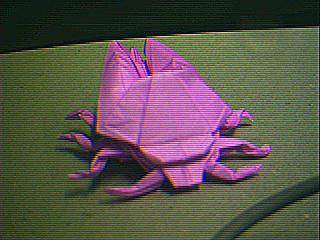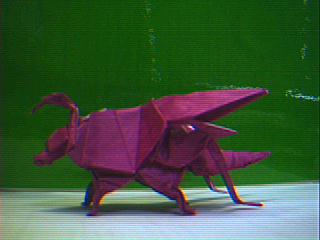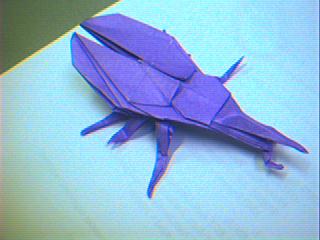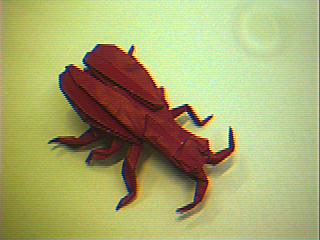 Moth.
Moth.
See also:
 Moth.
Moth.
Some of my favorite models are origami insects. This moth, given with lots of
details, is one of them.
 Stink
bug.
Stink
bug.
This animal is called a Stink-wants in Dutch. Someone wrote me: ik heb eens het genoegen mogen smaken er 1 te ontmoeten in een restaurant. ik schrok me wild! (I once had the pleasure to meet 1 in a restaurant. I was scared to death).
The folding sequence of the stink bug starts in the same way as the moth.
 Grashopper.
Grashopper.
Nice model, but the feet are made of many layers of paper on top of each
other. This model I made from paper of 34 by 34 centimeters: with smaller
paper, it becomes impossible for me to make certain folds.
 Spider.
Spider.
One of my favorites! Doable with some practice, and a large enough piece of paper. (I used 24 by 24 centimeters.)
Of course, the spider is not an insect, but it fits nicely here.
Lang's book contains many beautifull models. Unfortunately, they are also very hard to fold. Many tries from me ended up with a disposed piece of paper. Here are a few where I managed to complete the model.
 Tick.
Tick.
Lang has two different ticks in his book: a hungry one and one that has eaten. This is the hungry one. I couldn't make the other model look nice. (Paper ticks sometimes look nice, real ones probably never.)
Here we learn that a tick is not an insect, which can be observed from the
fact that it has eigth legs.
 Ant.
Ant.
We had several of these, not made of paper in the kitchen. Looking to them, I think I did something wrong with the legs. Still, not too bad, I think?
 Weevil.
Weevil.
This insect is said to destroy many harvests.
 Aspergus beetle.
Aspergus beetle.
Montroll has the skill to let his reader fold very detailed models, and they
are still doable. This is an excellent example. There are just one or two hard
steps, but the other steps are not to hard, after experience with easier
models.
![[Dept. ofComputer Science]](department.gif)
 HB's origami page hansb@cs.uu.nl.
HB's origami page hansb@cs.uu.nl.